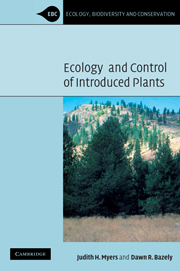Book contents
- Frontmatter
- Contents
- Preface
- 1 Introduction
- 2 Planet of Weeds: exotic plants in the landscape
- 3 Biological invasions in the context of plant communities
- 4 Predicting invasiveness from life history characteristics
- 5 Population ecology and introduced plants
- 6 Introduced plant diseases
- 7 Biological control of introduced plants
- 8 Modeling invasive plants and their control
- 9 Action against non-indigenous species
- 10 Genetically modified plants and final conclusions
- Appendix
- References
- Index
2 - Planet of Weeds: exotic plants in the landscape
Published online by Cambridge University Press: 02 December 2009
- Frontmatter
- Contents
- Preface
- 1 Introduction
- 2 Planet of Weeds: exotic plants in the landscape
- 3 Biological invasions in the context of plant communities
- 4 Predicting invasiveness from life history characteristics
- 5 Population ecology and introduced plants
- 6 Introduced plant diseases
- 7 Biological control of introduced plants
- 8 Modeling invasive plants and their control
- 9 Action against non-indigenous species
- 10 Genetically modified plants and final conclusions
- Appendix
- References
- Index
Summary
In this chapter, we consider the magnitude and scope of the invasive species problem, the language that is used when discussing introduced species, historical patterns of introductions, and the dynamics of colonization and spread. We also examine interactions between introduced species, habitat fragmentation and disturbance, and briefly describe some ecological theory relating to invasive species. We begin with a consideration of the role of invasive plants in the global environmental changes that are currently occurring.
The biota of the earth is dynamic both in the short-term and long-term. As students of evolutionary biology are quick to learn, most species that have ever existed on the earth have become extinct. For example, it is estimated that 96% of all species extant or living 245 million years ago may have become extinct (Raup 1979). Speciation and extinction are fundamental outcomes of evolutionary processes. However, rates of extinction vary over time and there have been periods of ‘mass extinction’, which can be seen in the fossil record as the disappearance of large numbers of species (Benton 1995, Eldredge 1997).
In the last 25 years, beginning with Norman Myers (1976), many biologists and ecologists have adopted and echoed the refrain that we are presently in such a period of accelerated extinction. But, unlike past episodes of mass extinction, this one is directly caused by human activities and has been termed the ‘Biodiversity Crisis’ (see definitions in Box 2.1) (Wilson 1985, Wilson and Peters 1988).
- Type
- Chapter
- Information
- Ecology and Control of Introduced Plants , pp. 14 - 50Publisher: Cambridge University PressPrint publication year: 2003

